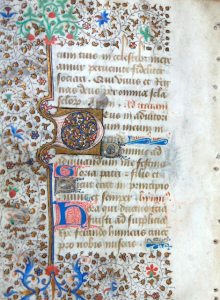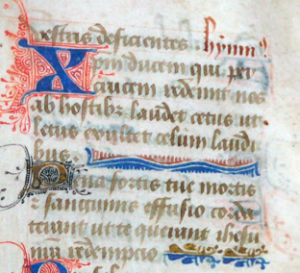At the beginning of our project, our group was assigned to study the Hours of the Virgin found within fol. 13v and fol. 41v of the University of Georgia Hargrett Book of Hours MS 836. In the context of Books of Hours, the Hours of the Virgin are usually very standard. They reflect the liturgical day for a layperson seeking to free their loved ones from purgatory by reciting each prayer assigned to a different hour of day. With the uniformity of this section we decided to deal with it pragmatically. The work was divided into sections with Jared transcribing, Sarah Kate cataloguing the decorations for the entire codex, Madison assisting the rest of the class in determining the use of the manuscript, and myself identifying any missing leaves and change in scribal hand. Our approach was simple, however there arose a slight problem.

When we began our transcription, we were completely lost. The Psalms typically used for each liturgical hour did not match our Hypertext transcription and only one rubric, or title, was present on fol. 18v marking the Terce hour. Initially we believed this to be our inexperience with the script lettre bâtarde and pursued other Books of Hours that accurately matched the Hargrett Hours. This too proved fruitless and we were back to square one again. Upon further review, we realized this manuscript was more unique than we anticipated. It was then decided to approach this text differently by dissecting the section in its individual parts, first starting with the Psalms, then the hymns, and onto the capitulums. With this approach we were free from the frustration of the inconsistencies between the Hargrett’s Hours of the Virgin and the Hypertext version, while matching any block of text to an online source to assist with transcription. Then, something incredible happened.
On fol. 15v line 2 begins the hymn “Christum Ducem,” and upon searching for these lyrics a manuscript from Copenhagen matched the lyrics exactly. Initially we believed this manuscript, listed as NkS 8° 27c, simply utilized the same hymns, however, the more we identified the more the manuscript matched our Hours of the Virgin. However, this manuscript from Copenhagen is not in fact the Hours of the Virgin, but Hours of the Passion.

Hours of the Passion might appear similar to Hours of the Virgin with the division of the liturgical day; however, they are more closely related to Hours of the Cross. The hours are divided into prayers that relate to the Passion of Christ and are much shorter than Hours of the Virgin. Hours of the Cross do not include Psalms or the Lauds hour and consists of versicles and responses, hymns, oratios, and a prayer. Hours of the Passion are simply an extended version of this to include Lauds, Psalms, and capitulums, and were not as popular due to their length.
Upon suspicion our section was in fact Hours of the Passion, it was important to be absolutely certain it was just that and not an extremely unique version of Hours of the Virgin. We relied heavily on the transcription of the Copenhagen Horae de Passione Domini as well as compared our section to other manuscripts containing the Hours of the Passion. The Terce Hour in our section became a vital marking point that allowed us to easily compare with other Books of Hours due to the absence of our opening leaves and rubrication. The common factors among our texts have been the hymns, the opening prayers, the capitulums, and oratios. The only variations between some of these manuscripts and our own are the Psalms, which are typically uniform in their use in Hours of the Virgin. However, our text is not the Hours of the Virgin but something relatively unique.
Our discovery provided even more questions. For instance, our “determining-use” liaison, Madison, explained the determined-use of the manuscript is reflected in both the Calendar section as well as in the Hours of the Virgin. While we have the calendar in our manuscript, there is the absence of the Hours of the Virgin and the inconsistent uses among the other manuscripts including Hours of the Passion. Manuscripts we have found fall under use of Paris, Rome, Bruge, and Sarum, and all have their own slight variations. Another problem presented in our discovery is the fact that the only transcribed version of Hours of the Passion is the Copenhagen manuscript stated above, making it difficult to compare. Therefore, our transcription is even more vital for further research of these unique prayers. The next step in furthering our research of the Hargrett Hours of the Passion is to determine the purpose of the opening leaves as it is the most inconsistent section and devoid of an opening leaf, as well as continuing to transcribe it while comparing it to other versions of Hours of the Passion.
Samantha Harper for Research Group 2 (Madison Hogan, Sarah Kate Johnson, Jared Long)
References
Bible Study Tools, Latin Vulgate http://www.biblestudytools.com/
British Library Book of Hours MS 50001 http://www.bl.uk/manuscripts/FullDisplay.aspx?ref=Add_MS_50001
British Library Bedford Hours MS 18850 http://www.bl.uk/manuscripts/FullDisplay.aspx?ref=Add_MS_18850
British Library Hours of Joanna of Castile MS 18852 http://www.bl.uk/manuscripts/FullDisplay.aspx?ref=Add_MS_18852
British Library Hours of the Passion, the Wardington Hours MS 82945 http://www.bl.uk/manuscripts/FullDisplay.aspx?ref=Add_MS_82945
British Library The Dunois Hours Yates Thompson MS 3 http://www.bl.uk/manuscripts/FullDisplay.aspx?ref=Yates_Thompson_MS_3
Horae de Passione Domini, KB NkS 27c 8° http://manuscripts.org.uk/chd.dk/nks/nks27c_h_passio.html
Hypertext Book of Hours http://www.medievalist.net/hourstxt/home.htm
The LiederNet Archive http://www.lieder.net/lieder/get_text.html?TextId=93118
University of Georgia Hargrett Book of Hours, MS 836
Wieck, Roger S. Time Sanctified. New York: George Braziller, 1988. Print.